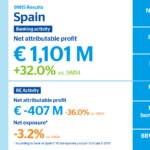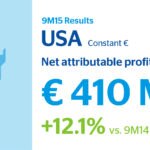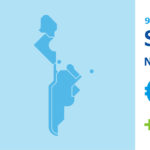Seven keys to BBVA’s income statement
To understand how BBVA’s income statement evolved over the first nine months of 2015, seven key points should be taken into account: earnings, revenues, corporate operations, risk indicators, capital, digital banking and lending.

1.- Earnings: The figure that best reflects on how BBVA has run its business over the course of the first nine months of the year is the attributable net profit excluding corporate operations: €2.82 billion, up 45.9% in y-o-y terms.
2.- Income: The second key is that gross income grew above 10%. As COO Carlos Torres Vila explained, “in such a complex environment, double-digit income growth rates testify to BBVA Group’s growth capacity and recurrence of results”. His words provide a spot-on summary of the two most relevant aspects of the past quarter: On one hand, a difficult context, with highly volatile global financial markets; and, on the other, the strong performance of the recurring revenues of the banking industry, despite this environment.
And, which are these recurring revenues? Basically two: The interest margin – the difference between what the bank charges on the loans it grants and what it pays its customers for the money they deposit in their accounts – and commissions. In quarterly terms, it is also worth noting that the bank posted a record gross income for the third quarter, €5.98 billion, a 14.5% increase compared to the same period of the previous year.


3Q15 Results presentation, Campus BBVA, Madrid.
3.- Corporate Operations: In third place, the aggregate earnings account for the first nine months of the year was also affected by the one-off impacts from corporate deals closed to date: partial sale of Chinese bank CNCB and the sale of CIFH, CNCB’s privately held subsidiary with corporate headquarters in Hong Kong; and the acquisition Catalunya Banc and of a 14.89% stake in Turkey’s Garanti bank. Also, the restatement at fair value of BBVA’s prior 25.01% stake in Garanti had a negative accounting impact, without a cash outflow, of €-1.84 billion. Factoring in these impacts, net profit stood at €1.7 billion, down 11.8% compared to the same period of 2014.
4.- Risk indicators: A fourth key development was the improvement of risk indictors, which bear witness to the bank’s quality credit rating. The Group’s NPL ratio improved to 5.6% at the close of September, compared to 6.1% a year earlier, with coverage of 74%. Also, BBVA reported quite positive numbers in terms of credit and real-estate exposure, with significant reductions in Spain.
5.-Capital: In fifth place, let’s take a look to the bank’s capital adequacy. The reference ratio to determine capital levels is the Common Equity Tier 1 or CET1 (phased in), which stood at 11.7% at the end of September, quite above current standard requirements. Applying future requirements of these standards (fully-loaded criteria), the ratio stood at 9.8%. As Carlos Torres Vila clearly stated at the beginning of his address, to look beyond these figures, one has to understand a quarter that was marked by market volatility and the impact of the depreciation of emerging country currencies against the dollar. The good news is that the evolution of the markets since the end of September to date would increase the ratio by about 20 basis points, and BBVA is expecting to close 215 with a 10% of CET1 fully loaded.

3Q15 Results presentation, Campus BBVA, Madrid.
6.- Digital Banking: The sixth key development is that BBVA continued to grow its base of customers who interact with the bank through online or mobile channels. For BBVA, digitization is, in Carlos Torres Vilas' own words, “a tool that will allow us to be more effective in selling and more effective in delivering a better service, more quality, a tool that will allow us to help our customers make decisions”.
And this change in trend is already translating into higher digital sales. For instance, according to September data, 23.7% of new consumer loans in Spain were sold through digital channels. BBVA Group already has 14 million digital customers, of which 7.6 million are mobile banking customers. The target is to reach 15 million digital customers by the end of 2015, of which 8 million would be mobile banking customers.
Meanwhile, BBVA has upgraded and fine-tuned its technology platforms to accommodate the exponential growth of digital operations. It is already capable of managing over 450 million transactions in real-time, and by 2017 the platforms will be capable of handling over 1 billion transactions.
7.- Lending: Finally, another key aspect was the evolution of the loans granted by the bank. BBVA Group's gross lending increased 18.1% in the last year, totaling €426,295 million. Customer deposits expanded at a similar pace and reached €388.86 billion, with growth across all business areas.

BBVA’s performance in Spain - the combined result of both banking and real estate activities - in Spain generated €694 million in the first nine months of the year, a y-o-y increase of almost €500 million. BBVA also posted solid results in new retail loans. For instance, new mortgage loans grew 43% over the last twelve months, excluding Catalunya Banc’s balances.

United States: generated earnings of US$410 million, 12.1% more than in the same period of 2014. Risk indicators remained at minimum lows. Activity expanded significantly: 12.7% in lending and 7.8% in customer resources.

Turkey: results already reflected the integration of Garanti in BBVA Group accounts by the full consolidation method. Turkey posted €249 million in profits for the first nine months of 2015, 7.3% more than a year before. Robust activity pushed NII plus commissions and fees higher in the third quarter. Turkey’s good credit quality indicators held steady.

Mexico: BBVA Bancomer, despite the current economic climate, continued posting solid numbers, including profits of €1.51 billion in the first nine months of the year, up 9.6% year on year. Loans and deposits continued growing at double-digit rates.

South America: The area managed to achieve 7.1% growth rates in attributable net profits, which stood at €689 million (€693 including Venezuela). The area continued benefitting from the behavior of recurring revenues and strong activity dynamics.